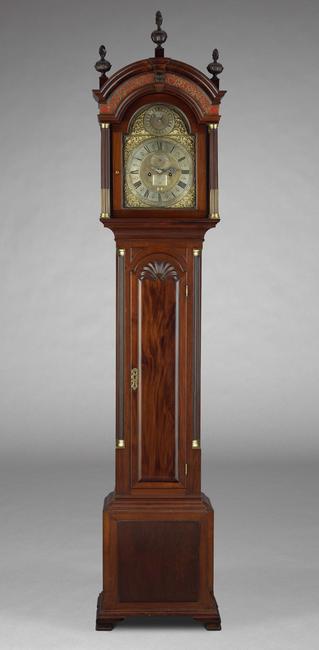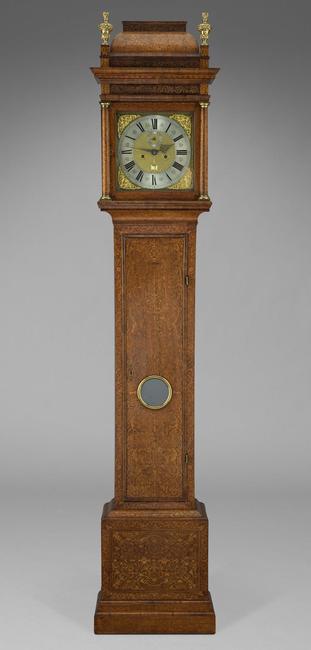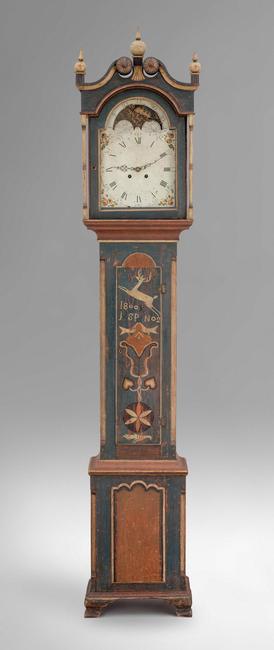The Beauty and Function of 18th- and 19th-Century Tall Case Clocks to be Examined in a New Exhibition Opening in November 2020 at the Art Museums of Colonial Williamsburg
Although it is common today for most people to own a personal timepiece, in centuries past it was not so. Marking time to the exact minute was a new innovation during the late 17th century, and the development of the tall case clock helped to make that possible. Until the early 19th century, only the wealthy could afford these expensive timepieces. Average people had little need for the precision these devices provided, relying instead on the location of the sun in the sky, sundials or public clocks to know the hour. As society became more dependent on time regulation, clocks became more necessary and innovations made them more attainable. How these timepieces evolved, were made and used will be explored in Keeping Time: Tall Case Clocks, a new exhibition of more than 20 tall case clocks from different regions spanning more than a century of timekeeping. Opening on November 14, 2020, in the Iris and Mark Coblitz Gallery at the DeWitt Wallace Decorative Arts Museum, one of the newly expanded Art Museums of Colonial Williamsburg, the exhibition will remain on view through December 31, 2022.

Art Museums of Colonial Williamsburg
“Colonial Williamsburg is unique in the nation in collecting, studying and exhibiting decorative arts from all parts of early America,” said Ronald L. Hurst, the Foundation’s Carlisle Humelsine chief curator and vice president for museums, preservation and historic resources. “This exhibition will feature clocks from New England, the Middle Atlantic and the American South as well as examples from England.”
Tall case clocks are weight-driven movements regulated by pendulums and housed in tall wooden cases. They were the products of two distinct trades: the clockmaker who put together the mechanical movement and the cabinetmaker (or joiner) who made the wooden case. Additional specialists might have cast the brass wheels (gears) for the movement, engraved or painted decoration on the dial, or produced decorative inlaid wooden elements or painted ornament on the clock cases. The style and design of both the clock movements and cases changed over time with innovations, evolving fashions, and regional preferences.
Organized in sections on clock movements, dials, Southern tall case clocks, plain vs. fancy design and table clocks, Keeping Time: Tall Case Clocks offers an encyclopedic survey on the topic.
“Much like today’s watches and clocks, 18th- and 19th-century tall case clocks, including those highlighted in this exhibition, followed national and regional trends in fashionable style and design,” said Colonial Williamsburg’s Curator of Furniture, Tara Chicirda. “These clocks were also customized with specialized mechanical features. Akin to the apps on today’s smart watches and cell phones, tall case clocks often incorporated extra applications, including those to tell the time of local high tides, the phases of the moon, or day of the month. Some allowed the owner to silence or mute the chime. Clocks with examples of each of these mechanisms will be shown in Keeping Time.”

Art Museums of Colonial Williamsburg
Among the highlights of Keeping Time is a tall case clock by clockmaker Thomas Planner of London, ca. 1700. The case is veneered with a small-scale foliate marquetry, known by some in the period, as filigree. At the end of the 17th century, European cabinetmakers often used veneers of different colored wood to create fashionable scroll-work floral marquetry patterns like this English example inspired by Italian design. The square brass dial, the stepped (or “sarcophagus”-shaped) hood and the filigree marquetry of this clock case were considered the height of fashion in London at the time. While the filigree faded from popularity within a decade or two, the overall case form continued to be produced in England and America for much longer. This clock is part of a recent bequest to the Colonial Williamsburg Foundation by long-time supporters and premiere American decorative arts collectors Joseph H. and June S. Hennage.
Another tall case clock featured in the exhibition was made by William Claggett, a London-born clockmaker who immigrated first to Boston and then to Newport, Rhode Island, between 1714 and 1716. He produced both square and arched dial clocks during his 30-year career in Newport. While this example was made ca. 1740, its case was made ca. 1765, suggesting that the owner later upgraded the case to reflect newer fashions. The clock’s arched dial provided space for specialized features in addition to the basic time and date. The small chapter ring in the arch includes the time of high tides in Roman numerals and the lunar calendar in Arabic numerals. The moon face within that ring revolves to represent the phases of the moon. Knowing the time of high tide and, therefore, when ships might sail was important to the people of a major seaport such as Newport. With the arrival of arched dials such as this example, mid-18th-century cases evolved to include arched tops. Concave and convex carved shells, like those on this clock case, also decorate many pieces of Rhode Island furniture produced during the mid- to late-18th century.
Southern tall case clocks reflected a variety of regional and international influences. One of the clocks to be seen in Keeping Time isfrom Virginia’s Shenandoah County. It was made in 1800 and exemplifies Pennsylvania influence in its overall form. The case was ornamented by Johannes Spitler, a decorative painter who descended from a Swiss Mennonite family that migrated from Pennsylvania to the Shenandoah Valley. His painted decoration on this clock reflects both the Germanic heritage of many of the settlers in the region as well as those in Pennsylvania and Spitler’s Swiss ancestry. Hearts, compass-drawn rosettes and animal figures, such as the leaping stag and the bird, are common motifs on German-American fraktur (illuminated manuscripts), pottery and painted furniture from Pennsylvania, Virginia and North Carolina. The construction of the clock with its numerous wooden pegs suggests it likely was also made by a craftsman of Germanic extraction in the Valley. Spitler painted the date “1800” and his initials, “J.Sp,” on the clock’s trunk door along with “No 2,” likely noting this as the second clock that he painted.

Art Museums of Colonial Williamsburg
Not all tall case clocks were elaborate, but even plain styles could be handsome, as exemplified by a clock that will be on view at the Art Museums for the first time. Made between 1819 and 1829 by Elijah Warner of Lexington, Kentucky, the clock case relies for its design success on figured cherry and mahogany and a well-proportioned form rather than more costly inlaid or carved elements. This streamlined, classical appearance became popular in coastal American cities during the 1820s and spread west with the movement of goods and people. While this clock case is relatively plain, the dial, made by entrepreneur clockmaker Luman Watson of Cincinnati, Ohio, is quite ornate with its neoclassical urn, flowers and delicate gilt filigree. Watson’s name appears on the dial, but other artisans, including an unidentified clockmaker with the initials “I.S.” and likely a specialist dial painter crafted the mechanism.
Keeping Time: Tall Case Clocks is generously funded by Mark and Iris Coblitz. For American furniture enthusiasts, timepiece aficionados and those interested in early American and British material culture, Keeping Time will be an essential exhibition to explore.
Colonial Williamsburg reopened at reduced capacity and has followed site-specific safety guidelines as part of the foundation’s COVID-19 business resumption plan and in accordance with the state’s plans for reopening. During Colonial Williamsburg’s reopening, most interpretive programming has been moved outdoors. For the safety of employees and the public, ticketed guests can expect limited interaction with interpretive staff. Site entry is limited by state-mandated capacity guidelines for social gatherings, and guests are encouraged to proceed quickly through interpretive sites to accommodate as many visitors as possible. 7
Face coverings are required while inside Foundation-owned buildings and their use is encouraged outdoors as well. Guests are also asked to adhere to social distancing guidelines during their visit to Colonial Williamsburg sites, when walking along Duke of Gloucester Street and in other publicly accessible areas. Most doors, faucets and other high-traffic touchpoints are now touchless, and there are significantly enhanced cleaning protocols throughout the foundation’s open locations.
Additional information about the Art Museums and Colonial Williamsburg as well as tickets are available online at colonialwilliamsburg.org, by calling (855) 296-6627 and by following Colonial Williamsburg on Facebook and @colonialwmsburg on Twitter and Instagram.
About the Art Museums of Colonial Williamsburg
The Art Museums of Colonial Williamsburg include the Abby Aldrich Rockefeller Folk Art Museum and the DeWitt Wallace Decorative Arts Museum, both of which are housed in their newly expanded building that offers an additional 65,000-square-feet of space, 25-percent more gallery space and numerous enhancements to the visitor experience.The Abby Aldrich Rockefeller Folk Art Museum is home to the nation’s premier collection of American folk art, with more than 7,000 folk art objects made up to the present day. The DeWitt Wallace Decorative Arts Museum exhibits the best in British and American fine and decorative arts from 1670–1840. The Art Museums of Colonial Williamsburg are located at 301 South Nassau Street in Williamsburg, Va. Open daily from 9:00 A.M. to 6:00 P.M.
About The Colonial Williamsburg Foundation
Colonial Williamsburg operates the world’s largest living history museum, preserving Virginia’s 18th-century capital as a fully functioning city. Fun, engaging experiences transport guests back in time and highlight the relevance of America’s founding era to contemporary life. The Colonial Williamsburg experience includes more than 600 restored or reconstructed buildings, historic trade shops, renowned museums of decorative arts and folk art, extensive educational outreach programs for students and teachers, lodging, culinary options from historic taverns to casual or elegant dining, the Golden Horseshoe Golf Club featuring 45 holes designed by Robert Trent Jones Sr. and his son Rees Jones, a full-service spa and fitness center managed by Trilogy Spa, pools, retail stores and gardens. Philanthropic support and revenue from admissions, products and hospitality operations sustain Colonial Williamsburg’s educational programs and preservation initiative.










